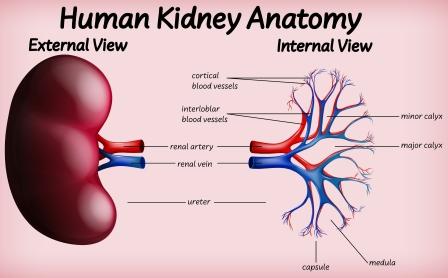Just like we make sure we drink filtered water or love our filtered coffee to work throughout the day, our body too functions similarly anatomically. Our body needs to have filtered blood, and that’s what two bean shaped kidneys are for.
Located just below the rib cage on both the sides of the spine, kidneys filter about half a cup of blood every minute, eventually removing waste and extra water that goes out of the body through urine.
Kidneys are multifunctional, and we can definitely fall sick if something messes up during the process, even die in severe cases. So in this blog, you are going to know in and all about the kidney’s anatomy, its tiny little parts, and all the work it does inside the human body.
What should you know about Human Kidney Anatomy?
So as said earlier, human kidneys are the pair of bean-like organs situated on both the sides of the spine, basically below the ribcage, and bind the belly. They are around 4 or 5 inches long, almost the size of your fist. They weigh approximately about 125 to 175 grams in males and 115 to 155 grams in females.
They are specifically protected by an ample amount of fat, ribs at the back, and muscles inside the body. The fat is called perirenal fat, which protects both kidneys from any kind of external damage. The opening and closing of the kidneys are called renal hilum.
Although small as your fist, kidneys are the most essential organs of your body. One third of all the blood in our body goes into the kidney to get filtered before it goes into cells and tissues in the body.
So when the kidneys have issues, your entire body may lead to various complications, including edema or swelling of the extremities, or say fluid in the lungs, increased potassium levels in the blood, anemia, heart disease, and pericarditis.
Kidneys consist of different tiny parts inside them that altogether function to carry out the process of filtration. And so here are the different parts of kidneys that you should know about.
Different Parts Of Kidney and Their Functions

Inside a small kidney, there is a lot that goes on. Everything is carried out by a particular part of the kidneys, and so here’s what you should know.
Nephrons
Nephrons are one of the most important parts inside the kidney for their functionality. They are basically the powerhouse of kidneys. As the blood enters the kidney, it goes straight into the nephrons.
It metabolizes nutrients and passes out the waste from the filtered blood. There are around 1 million nephrons in each kidney.
Nephrons again have their own internal structure of their own, which consists of a renal corpuscle and renal tubules.
So once the blood enters the nephrons, it first goes directly to the renal corpuscle. The renal corpuscle has two additional structures called the glomerulus and the bowman’s capsule.
- The glomerulus is made up of a cluster of capillaries that absorb protein from the blood that travels through the renal corpuscle.
- The remaining fluid that contains no necessary nutrients further passes through the bowman capsule into the renal tubules.
So after the bowman’s capsule, the fluid enters renal tubules. Renal tubules contain a lot many tubes that further take part in the process of filtration.
Renal tubules contain three different structures, proximal convoluted tubule, a loop of Henle, and distal convoluted tubule.
- The proximal convoluted tubule is functioned to add water, sodium, and glucose back into the blood that goes to cells and tissues of the body.
- The loop of Henle adds potassium, chloride, and sodium into the blood that goes to cells and tissues of the body.
- Distal convoluted tubule adds more sodium into the blood and takes in potassium and acid that goes to cells and tissues of the body.
So till the fluid reaches the end of the tubules, it contains urea that is further realized out through urine.
So nephrons basically filter the fluid with the help of renal corpuscle and renal tubules.
Renal Cortex
The other part of the kidney is called the renal cortex, which contains convoluted tubules and glomerulus. It is surrounded by a renal capsule on its outer edges. It is a thick layer of fatty tissues.
The renal cortex, along with the help of the capsule house, protects the inner structure of the kidney.
Renal Medulla
This is the inner part of the kidney, which consists of medullary collecting ducts, vasa recta, loops of Henle, and the interstitium. It plays a vital role in the regulation of urine concentration and other functions of the kidney.
It contains two further parts, namely, renal pyramids and collecting ducts. Renal pyramids contain the strings of nephrons that transport fluid into the kidney. Collecting ducts are placed at the end of each nephron inside the renal medulla from where the fluid moves at the end of the renal pelvis.
Renal Pelvis
This is the structure present in the innermost part of the kidney, which is the pathway for fluid out of the bladder. The renal pelvis consists of calyces, hilum, and ureter.
Calyces is a small shaped space in which all the fluid is collected before it goes to the bladder. It is the same -place where the fluid and waste becomes urine.
The hilum is a tiny opening on the inner side of the kidney, through which the renal pelvis passes. It is also the same place through which the renal artery and renal vein pass. Renal arteries bring oxygenated blood from the heart to the kidney for filtration, and the renal vein carries the filtered blood from the kidney back to the heart.
The ureter, on the other hand, pouches urine into the bladder.
So these are the different parts of the kidney and their major functions. So let’s know how exactly this all goes on inside our body.
How do kidneys work (Vascular Supply)

The functioning of kidneys is quite simple yet a bit complicated at the same time. Kidneys receive blood through renal arteries, major direct branches of the abdominal aorta.
There are millions of filtering units inside kidneys called nephrons. Each of these nephrons consists of a glomerulus and a tubule which works in two step process.
So first, the glomerulus filters the incoming blood, and then tubules remove the waste and return the necessary blood.
Blood enters the body through renal arteries, which are further divided into smaller branches of blood vessels till it reaches nephrons. This process happens every second. Approximately in 24 hours, our kidneys filter around 150 quarters of blood. And that’s how this all happens throughout the day inside the kidneys.
Major Functions of Kidneys
Kidneys play a vital role in our over health, and it’s all because of their functionality. It removes waste and unnecessary extra fluid from the body, making more space for essential minerals and nutrients.
It also removes harmful acid that is produced by the cells and maintains a perfect balance of essential salts and minerals like calcium, sodium, potassium, and phosphorus in your blood.
Even a tiny fluctuation in this balance can affect your muscles, nerves, brain, and other tissues of the overall body.
Kidneys also make essential hormones that control our blood pressure, develop red blood cells, and even help keep your bones strong and healthy.
So basically, it is important that we keep our kidneys healthy to keep our overall body fit and fine. To help you with that, here are some of the causes of chronic kidney diseases that you should know.
What causes kidney diseases?
So kidney diseases are basically any condition that causes kidney malfunctioning or abnormality in its working pattern.
Diabetes, high blood sugar, and protein in urine for longer duration can often be one of the main reason that causes kidney diseases. Some such conditions can be inherited, while others can be due to an unhealthy lifestyle.
It is often seen that few individuals are born with various abnormalities that cause kidney diseases.
Glomerulonephritis is one of the most common kidney diseases which causes inflammation in the kidney filtering unit called glomeruli. This disease may get severe over a period of time and lead to loss of kidney functioning.
Apart from that, kidney diseases include Polycystic kidney, kidney stones, urinary tract infections, congenital disorders, and other such.
The best way to prevent yourself from these diseases is to maintain a healthy lifestyle and diet. So here are the few foods that you should definitely include in your diet to keep your kidneys healthy.
Foods that keep your Kidneys healthy
We all want to stay healthy and fit. And since the kidney plays a vital role in that, we definitely want to make sure that we feed our body right to keep the kidneys functioning right.
So here are the best foods you should include in your diet.
- Cauliflower
- Blueberries
- Red grapes
- Egg whites
- Garlic
- Olive oil
- Fish
- Kale
- Spinach
- Sweet potatoes
So yes, it’s just that simple. Since we can clearly see its lot and lot of veggies that play a vital role in keeping the kidney healthy and fine, make sure you have them in enough quantity in your diet.
If you consume alcohol, frequently we recommend lowering its consumption, especially if you have kidney issues in heredity. So fill your plate with veggies and other foods mentioned above, and your kidneys will definitely throw the waste out of your body forever.


